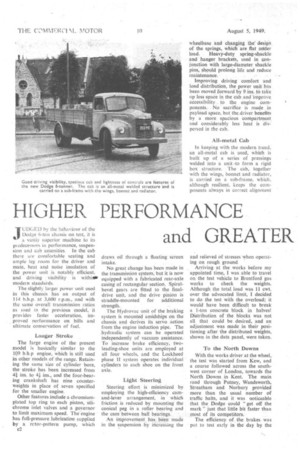HIGHER PERFORMANCE and GREATER COMFORT
Page 38

Page 39

If you've noticed an error in this article please click here to report it so we can fix it.
UDGIED by the behaviour of the Do(Ie 6-ton chassis on test, it is
a vastly superior machine to its predecessors in performance, suspension and cab amenities. In the cab there are comfortable seating and ample leg room for the driver and mate, heat and noise insulation of the power unit is notably efficient, and driving visibility is with jib modern standards_
The slightly larger power unit used in this chassis has an output of 114 b.h.p. at 3,600 ep.m., and with the same overall transmission ratios as used in the previous model, it provides fastei acceleration, improved performance on hills and ultimate conservation of fuel.
Longer Stroke The large engine of the present model is basically similar to the 109 bh p engine, which is still used in. other models of the range. Retaining the same size of cylinder bore, the stroke has been increased from 41ins. to 41 ins., and the four-bearing crankshaft has nine counterweights in place of seven specified for the smaller engine.
Other features include a chromiumplated top ring to each piston, silichrome inlet valves and a governor to limit maximum speed. The engine has full-pressure lubrication supplied by a rctor-pattern pump, which c2 draws oil through a floating screen intake.
No great change has been made in the transmission system, but it is now equipped with a fabricated rear-axle casing of rectangular section. Spiralbevel gears are fitted to the finaldrive unit, and the drive pinion is straddle-mounted for additional strength.
The Hydrovac unit of the braking system is mounted amidships on the chassis and derives its servo action from the engine induction pipe. The hydraulic system can be operated independently of vacuum assistance. To increase brake efficiency, twoleading-shoe units are employed at all four wheels, and the Lockheed phase 11 system operates individual cylinders to each shoe on the front axle.
Light Steering
Steering effort is minimized by employing the high-efficiency camand-lever arrangement, in which friction is reduced by mounting the conical peg in a roller bearing and the cam between ball bearings..
An iMprovernent has been made in the suspension by increasing the and relieved of stresses when operating on rough ground Arriving at the works before my appointed time, I was able to travel on the test vehicle to Brentford gas works to check the weights. Although the total load was 11 cwt. over the advocated limit, I decided to do the test with the overload; it would have been difficult to break a 1-ton concrete block its halves! Distribution of the blocks was not all that could be desired, and an adjustment was made in their positioning after the distributed weights, shown in the data panel, were taken.
To the North Downs With the works driver at the wheel, the test was started from Kew, and a course followed across the southwest corner of London, towards the North Downs in Kent. The main road through Putney, Wandsworth, Streatham and Norbury provided more than the usual number of traffic halts, and it was noticeable that the Dodge could "get off the mark" just that little bit faster than most of its competitors.
The efficiency of the brakes was put to test early in the day by the has an average gradient of 1 in 5.1. Radiator top tank and atmospheric temperatures were taken before starting the climb, and readings of 147 and 65 degrees F. respectively recorded.
Bottom gear was used to negotiate the 1-in-5 section over the railway bridge, and a rapid, although not entirely noiseless, change to second ratio was made as the hill flattened out to 1 in 9. This treatment, because of loss of road speed and increase in incline, evoked loud detonation from the power unit, and a change 'back to_ bottom gear was soon made.
Engine speed began to drop as we rounded' the bend on the 1-in-41 gradient, and it was evident that anything more severe might have brought the Dodge to a halt. Much may be said in praise of the machine'
























































































